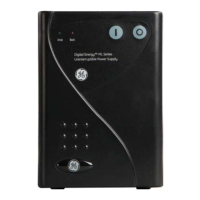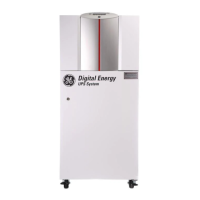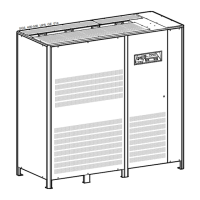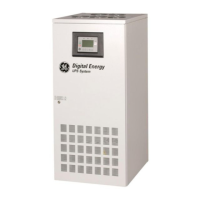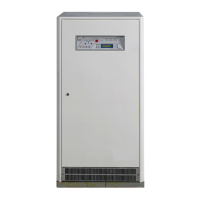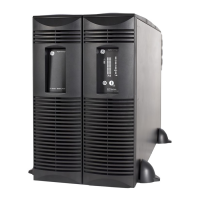
Do you have a question about the GE Digital Energy GT6000 and is the answer not in the manual?
| Brand | GE Digital Energy |
|---|---|
| Product Category | UPS |
| Model | GT6000 |
| Power Rating | 6000 VA |
| Input Voltage | 208/220/230/240 VAC |
| Input Frequency | 50/60 Hz |
| Output Voltage | 208/220/230/240 VAC |
| Output Frequency | 50/60 Hz |
| Efficiency | Up to 95% |
| Typical Backup Time | Varies with load |
| Runtime | Varies based on load |
| Communication Interface | RS-232, USB |
| Operating Temperature | 0 to 40°C (32 to 104°F) |
| Humidity | 0% to 95% non-condensing |
| Battery Type | Valve-regulated lead-acid (VRLA) |
Instructions must be followed during installation and maintenance of the UPS.
Essential rules and warnings for safe operation and maintenance of the UPS.
Overview of the GE Digital Energy GT Series UPS and its purpose.
Specifies the types of equipment the UPS is designed to protect.
Guidelines for safely moving and storing the UPS unit.
Details the warranty period and conditions for GE UPS products.
Lists all items included in the UPS and battery cabinet shipping boxes.
Essential guidelines and conditions for installing the UPS safely and correctly.
Steps for preparing and mounting the UPS in a 19-inch rack.
Steps for preparing and installing the UPS in a vertical tower format.
Instructions on how to connect the battery pack(s) to the UPS unit.
Describes how to connect communication devices like DB9 or SNMP cards.
Identifies and describes the various ports and connectors on the UPS rear panel.
Step-by-step guide for connecting the UPS to mains power and load.
Information on connecting multiple UPS units for parallel operation.
Guidelines for setting up a system with multiple UPS units in parallel.
Steps for physically connecting UPS units in a parallel configuration.
Description of the UPS front panel buttons, LEDs, and indicators.
Instructions for starting up a single UPS unit or a parallel system.
Conditions and status for normal UPS operation.
Procedure for safely shutting down the UPS unit.
Explains the meaning of various LEDs and alarms on the UPS front panel.
Details the UPS operation when the load is supplied directly by mains.
Describes UPS behavior when running on internal battery power.
Indicates when battery power is critically low and shutdown is imminent.
Signals when input voltage or frequency is outside acceptable limits for bypass.
Explains what happens when the UPS is overloaded and how it responds.
Indicates when UPS batteries need replacement due to age or fault.
Explains alarm behavior and different fault conditions the UPS may enter.
Describes the UPS fault modes and recovery.
Describes the UPS stand-by state and how to enter it.
How to connect an external emergency off device to the UPS.
How to remotely control the UPS power status using a switch.
How the UPS behaves when there is no load connected.
How to configure the UPS to automatically restart after a power event.
Features and tests related to UPS battery health and performance.
Details on connecting the UPS via a serial DB9 port for monitoring.
Information about using an SNMP card for network connectivity.
How to increase the UPS runtime using external battery packs.
Safety warnings and procedures for performing maintenance on the UPS.
Basic maintenance recommendations for the UPS unit.
Guidelines for environmentally responsible disposal of the UPS.
Information on battery service life and replacement.
Detailed steps for safely replacing the UPS batteries.
A guide to diagnose and solve common UPS problems and their solutions.
Technical specifications for different UPS models, including VA and Watts.
Details on the UPS input voltage, range, waveform, and current.
Details on the UPS output voltage, frequency, waveform, and power factor.
Information regarding the UPS bypass voltage and frequency tracking.
How the UPS handles overload conditions and short circuits.
Details on battery capacity, type, and expected runtime under various loads.
General physical and weight specifications for the UPS units.
Information on operating temperature, humidity, and noise levels.

